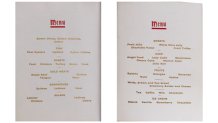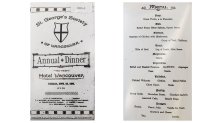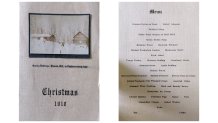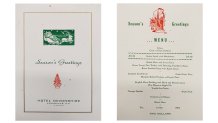The menu for the annual dinner of St. George's Society in Vancouver, British Columbia, featured the fresh catch that the city is known for: boiled salmon with oyster sauce from the Fraser River.
The longest river in British Columbia, the Fraser flows 854 miles from the Canadian Rockies into the Strait of Georgia just south of Vancouver. It has long been famous for its salmon -- sockeye, chinook, chum, coho and pink.
But that menu was from 1886, and since then, the salmon has struggled. Recently, the Fraser has recorded some of the highest but also the lowest numbers of the last 100 years of sockeye returning from the ocean to spawn. Environmentalists and others point to development along the river and warming ocean waters that are a result of climate change.

Vancouver's past through menus
Fisheries biologist William Cheung of the University of British Columbia in Vancouver has been collecting data for more than a decade on how those warming waters are changing what fisheries catch. But he also wanted to know how people were affected and one way was to investigate what was being served at the city's restaurants.
He and his team, including one of his students, John-Paul Ng, went in search of historical menus. What would they show about this city that boasts of its fresh seafood? Would they document the changing climate through the daily specials?
They collected 362 menus from the city’s restaurants, historical societies and museums and analyzed them over four different time periods: 1880 to 1960, 1961 to 1980, 1981 to 1996, and 2019 to 2021.

In addition to the menu for the St. George's Society dinner, they found one for the Fireman's Ball in 1904 with raw oysters, oyster patties and halibut. And for Christmas dinner at the Hotel Vancouver in 1949, one that featured a lobster and crabmeat cocktail and a paupiette of fillet of sole in croustade. The Commodore Supper Dance specials of the late 1950s included a crabmeat cocktail and fresh crab legs.
"That provides us with a really long-term baseline of what was offered then and as a contrast to what we are having in seafood restaurants now in the city," Cheung said.


What the menus show
To track the changes, they created an index called the Mean Temperature of Restaurant Seafood of the preferred water temperatures for species on the menus. That mean was about 10.7 degrees Celsius in the 1880s or 51.26 degrees Fahrenheit. It has risen to 13.8 Celsius or 56.84 degrees Fahrenheit.
And they discovered that today's favorites in British Columbia, especially the cold-water sockeye salmon and halibut, are sharing places on menus with warmer weather species such as Humboldt squid.
"It is not a species that we can find occurring in seafood menus even a few decades ago not to mention 100 years ago," Cheung said. "It’s becoming increasingly common in seafood menus now."
"And we know that Humboldt squid live generally in south of British Columbia. Its natural range is in California, in Oregon, and we also know that in the last few years particularly when the Pacific warms up a lot, the range, the distribution of Humboldt squid actually expands to British Columbia," he said.

He also is monitoring Pacific sardines, another species that prefers warmer temperatures. They were fairly common on seafood menus in Vancouver 50 years ago but disappeared for environmental reasons and overfishing, he said. The sardine fisheries collapsed in the 1950s.
"We want to see maybe in the next few years whether Pacific sardines become more abundant in British Columbia," he said.
They will also want to see whether Pacific sardines once again become popular on menus as they were when oceanographic conditions, including temperature, favored them as far north as British Columbia, he said.
As the climate keeps warming, salmon and halibut will likely continue to be edged out. Last year, during a drought in British Columbia, streams ran dry, and tens of thousands of salmon died. Cheung is concerned that the price for locally caught salmon will rise and make it a luxury item for many.
"If they have to import sockeye salmon from Alaska for example, then whether that will increase the cost," he said.

Clima Cafe
The archival menus from Vancouver's restaurants show how climate change has affected what chefs have prepared over the last century.
But what about the future?
Here's a menu that looks at the threats to some of America's favorite foods, whether from heat waves, droughts, floods or hurricanes.
Clima Cafe gives a glimpse at how global warming may change what we eat even more dramatically going forward.
Nina Lin and Noreen O'Donnell / NBC

